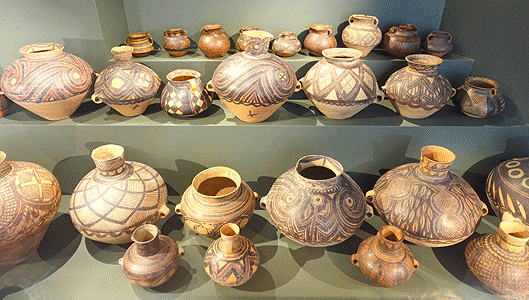
Xiawanggang Longhouse

Yangshuo culture is a Neolithic culture located in northern China along a stretch of the Yangtze (Yellow) River. It flourished between c. 5000 BCE to 3000 BCE primarily in the Central Plains provinces of Henan, Shaanxi and Shanxi, regarded as the Chinese cradle of civilization. In the early phase of the late Neolithic, agricultural settlements appeared with increasing population, area, and hierarchical organization. One example of these settlements is Xiawanggang in the middle Han Valley. It is 1000–2000 sq. m in size, and has two rows of houses or longhouses. One house row at Xiawanggang has been excavated, and measured measured 79 meters in length, consisting of 29 rooms joined in a single terrace (shown in this CG model). Assuming an average of 4 persons to a household, each row could have held 100 people, giving a total of 200 for the whole settlement. Each independent unit of the row likely housed a nuclear family and included an entrance hall, and one or two rooms at the back. All entrance doors face southward. Each longhouse was likely a communal residence for a patrilineal family. The main food was millet, though some evidence of rice has been found. Yangshao agriculture, whether small-scale slash-and-burn cultivation or intensive agriculture in permanent fields, is currently a matter of debate. When the soil was exhausted, residents moved to new lands, and constructed new villages. The Yangshao people kept pigs and dogs, and rarely sheep, goats, or cattle. Most of their meat came from hunting and fishing with stone tools. They may also have practiced an early form of silk production and hemp weaving. Yangshao artisans created fine white, red, and black painted pottery with human facial, animal, and geometric designs. The pottery was hand coiled without the use pottery wheels. Excavators found that children were buried in painted pottery jars.
Elevation is c.1220 m. (4000 ft.) above sea level.
Construction: Foundations and floors were rammed earth, with walls above of lattices of wattle, plastered with layers of mud. The matrix of plastered walls supported roofs composed of thatched millet stalks.
Sources of data for CG model:
1. Allen, Sarah, ed. 2005; The Formation of Chinese Civilization, An Archaeological Perspective; Chapter 3: Zhongpei, Zhang; The Yangshuo Period: Prosperity and the Transformation of Prehistoric Society: Yale University and New World Press, 2005.
https://www.google.com/books/edition/The_Formation_of_Chinese_Civilization/sP-PN2StH2cC?hl=en&gbpv=1&dq=Xiawanggang+longhouse&pg=PA76&printsec=frontcover
2. Shinan, Ren, 2000; The Emergence and Development of Neolithic Settlement in Ancient China, published in Archaeology, 1007.7; 624-63.



